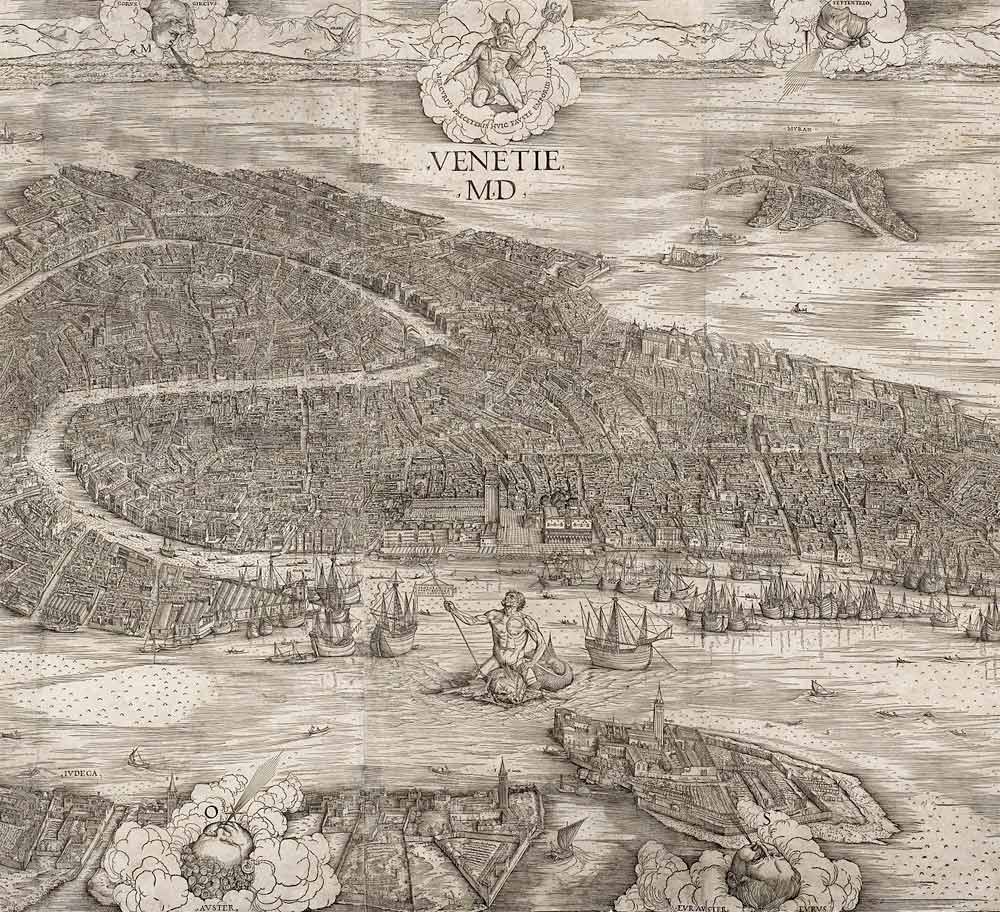This page documents the evolution of printing and publishing during the sixteenth century. When this century started, the printing press had been in existence for around 50 years. It had spread throughout Europe and more than 10 million copies of nearly 3500 works had already been printed. The animated GIF below shows the spread of printing presses in the past centuries. It is unfortunately not entirely accurate, omitting, for example, the first Brazilian printing press in 1808.
1500 – Early aerial map
Painter and engraver Jacopo de’ Barbari publishes a huge 1.3 by 2.8 meter aerial map of Venice, printed using six woodcut blocks. It took him three years to create the spectacular bird’s eye view. The map is so detailed historians still use it today to study 16th century Venice. Click its center part shown below for an enlarged view.
1507 – Chiaroscuro
The chiaroscuro oil painting technique is applied to woodcuts by artists like Lucas Cranach and Ugo da Carpi. In a chiaroscuro woodcut, a drawing is reproduced using two or more blocks printed with different colors or tints. One of the blocks can be a line drawing but in the work shown below, ‘Lovers surprised by Death’ by Hans Burgkmair, only three tints are used. In Germany the technique peaks around 1520, but in Italy this early form of color printing remains in use throughout the sixteenth century.
1509 – Waldseemüller map
Around a thousand copies of the Waldseemüller map (Universalis Cosmographia) are printed by German cartographer Martin Waldseemüller. The map consists of twelve woodcut prints that each measure 46 cm × 62 cm (18 by 24.5 inches). It is the first map to use ‘America’ as the name of the newly discovered continent.

1514 – Authorship
In the early days of printing, authors do not get paid for their work. Writing is done to make a name for oneself. The German satirist, poet, and translator Thomas Murner is likely the first author who gets paid for his writings. Writing for money continues to be considered bad manners until the middle of the 18th century.
1520 – Fraktur
German publisher Johann Schönsperger and punch-cutter Hieronymus Andreae create the Fraktur typeface. Various iterations remain the typical German letter for 400 years, with Antiqua gradually replacing it in the 19th century. The overall style is still popular today as a display typeface for advertising.

1522 – Scribes still publish manuscripts
Even though movable type revolutionized book production, some types of works are still done by scribes. The Tsgrooten Antiphonary is a beautiful example of a hymn book that is created and decorated by hand.
1524 – I Modi
Also known as ‘The Sixteen Pleasures’, this set of 16 erotic engravings by Marcantonio Raimondi shows that it are not only religious works that get printed. The catholic church manages to destroy all the printed copies but a new edition, accompanied by explicit sonnets written by the poet Pietro Aretino, gets printed in 1527.
1525 – Dürer engravings
The famous painter, wood carver, and copper engraver Albrecht Dürer publishes ‘Unterweysung der Messung’ (A Course on the Art of Measurement), a book on the geometry of letters.
1534 – Cambridge University Press
Henry VIII grants the University of Cambridge the right to publish books, making CUP the world’s oldest publishing house still in existence. Its mission is ‘to further the University’s mission by disseminating knowledge in the pursuit of education, learning, and research at the highest international levels of excellence.’
1539 – First press in the New World
The Spanish king and the archbishop of Mexico City approve the installation of the first printing press in Mexico. Today the building where it was installed (Casa de la Primera Imprenta de América) houses the Book Museum.
1543 – Vesalius anatomy books
De humani corporis fabrica libri septem (On the fabric of the human body in seven books) is a book of human anatomy written by Andreas Vesalius. It combines text with numerous illustrations and shows how much printing has evolved during this era.
1548 – Pocket atlas
In Venice, Giacomo Gastaldi publishes Geography, the first pocket atlas. It is one of the first books to show regional maps of the Americas. The image below shows the atlas as well as Gastaldi’s map of Moskovia, the Grand Duchy of Moskow.






It reached Goa in 1556, ten years earlier than mentioned above. Also, while it is seen largely in religious terms, the press played a far bigger role in promoting languages, and transporting Asian information to Europe.
You’re right and I fixed this. Thanks for pointing out the error.
Thank you for the history of books
I found a german book dated 1504 and i wanted to know this fascinating history i love books they are my life
…